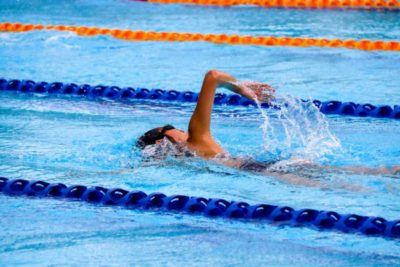To participate in an American Red Cross Lifeguarding course, you must take and pass a pre-course skills test. There are certain skills you must have prior to participating – the pre-course skills test shows the instructor you are capable of being a lifeguard.
What is the pre-course skills test?
The test has 3 pieces. One to test swimming ability, one to test swimming with an object, and one to test your ability to keep your head above the surface.
Part one: You must complete a 300-yard swim.
Sounds simple enough. However, there is a standard to the swim.
You must swim on your stomach. You can swim using front crawl or breaststroke technique. You can’t be on your side or back during the swim.
You must keep moving forward. That means you can’t sit on the wall, stand up, grab a lane line, or stop.
You must demonstrate rhythmic breathing. Rhythmic breathing is a consistent breathing pattern. You can’t swim with your head up constantly or come to a stop to breathe while swimming.
You must finish. You must complete the entire 300-yard distance.
You can use goggles. You are strongly encouraged to bring properly fitting goggles.
Once you complete your swim, typically you will have a rest while the rest of the class completes that portion.
Then, on to part two: a timed object retrieval.
The timed object retrieval is a timed swim with a surface dive to retrieve a 10lb object then return to the start point.
Here are the standards:
- Starting in the pool – the instructor starts the participant and the clock.
- The participant swims 20 yards on their stomach.
- They surface dive to a depth of 7-10 feet and retrieve an object from the bottom.
- Swim to the surface and kick on their back to the start point using without using their arms.
- Place the object on the deck and climb out without using stairs.
All of that must be completed under 1 minute and 40 seconds. Participants are not allowed to use goggles for this portion of the pre-course.
That brings us to the third part of the test: 2 minutes of treading.
The 2 minutes of treading is simple. Participants must keep their heads above the surface and tread by kicking and not using their arms. Typically, participants cross their arms or have their hands slightly above the surface.
How to ensure you are successful with your pre-course skills test
To be successful with the pre-course, participants must complete all three parts to the required standard.
Completing the skills test successfully allows participants to continue through the remainder of the class. Physically, these skills end up being perceived as the hardest part by most participants.
Key things for participants to do prior to the skills test
- Practice! Get in the water, practice swimming. Focus on relaxing while swimming to make sure you can make the distance without getting too tired. Leaning forward and practicing a breathing pattern often help participants with the initial 300-yard swim.
- Practice!! Yes, it is necessary to say it again. This time, practice surface diving down 10-12 feet. Look up how to do an efficient head first AND feet first surface dive down to the bottom. Get in the pool and practice it. Get to the bottom and open your eyes. You are not able to use goggles during part 2 of the skills test.
- Can you guess? Practice… Get in and start treading with just your legs. Keep your head up and start doing it longer and longer. You must do it for 2 minutes without using your hands or grabbing onto the side or lane line.
It might sound repetitive but yes, all you should do beforehand is practice. Find a local pool, you can usually find one you can use for less than $10 per visit.
What now?
Just remember that the American Red Cross Lifeguard Course begins with the pre-course skills test. You must be able to demonstrate those skills to continue through the class.
Give yourself time to practice before the start of your class. Don’t wait until the day before to get to work.
Get out there and practice!
Good luck!

